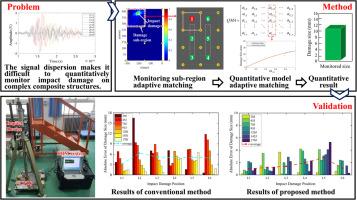GW imaging enabled adaptive quantitative monitoring of impact damage
IF 9.4
1区 工程技术
Q1 ENGINEERING, MECHANICAL
International Journal of Mechanical Sciences
Pub Date : 2025-09-23
DOI:10.1016/j.ijmecsci.2025.110884
引用次数: 0
Abstract
Due to the poor resistance to impact, composite aircraft structures are prone to impact damage during service, which may significantly reduce the load-bearing capability and flight safety. The guided wave (GW) based structural health monitoring (SHM) method has proved to be effective and promising in diagnosing impact damage of composite structures, therefore has been widely researched. When considering GW based quantitative monitoring of impact damage, there exists a major concern that the dispersion caused by complex structural form and damage development will severely affect the monitoring accuracy of damage size. Aiming at accurate size estimation of impact damage for complex composite aircraft structures, this paper proposes for the first time an imaging improved adaptive quantitative monitoring method. In this method, a multi-domain feature fusion enhanced quantitative diagnostic model is first established for every sub-region of structure divided by the adopted piezoelectric transducer (PZT) network. Then the PZT network-based GW imaging is performed to locate the sub-region that impact damage occurs, and enable the adaptive selection of the corresponding quantitative diagnostic model, by which the dispersion can be effectively avoided and the damage size can be accurately estimated. Experimental research is conducted on stiffened carbon fiber panel structures of aircraft to analyze real impact damage caused influence on GW signal and verify the proposed method. Through generating impact damages with different positions and sizes on one stiffened structure by impact hammer, quantitative monitoring models corresponding to different sub-regions are established and used to estimate damage size on another stiffened structure. The average error of size estimation of impact damages at different sub-regions is only 1.7 mm, which demonstrates the effectiveness of the proposed method and its potential in quantitative damage monitoring of large-scale composite aircraft structures.

GW成像实现了冲击损伤的自适应定量监测
由于复合材料飞机结构抗冲击能力差,在使用过程中容易发生冲击损伤,严重影响飞机的承载能力和飞行安全。基于导波的结构健康监测方法被证明是诊断复合材料结构冲击损伤的有效方法,因此得到了广泛的研究。在考虑基于GW的冲击损伤定量监测时,复杂的结构形态和损伤发展所引起的弥散将严重影响损伤尺寸的监测精度。针对复杂复合材料飞机结构冲击损伤尺寸的精确估计,首次提出了一种成像改进的自适应定量监测方法。该方法首先对采用压电传感器(PZT)网络划分的每个结构子区域建立多域特征融合增强定量诊断模型;然后,利用基于PZT网络的GW成像技术对冲击损伤发生的子区域进行定位,并自适应选择相应的定量诊断模型,有效避免了冲击损伤的分散,准确估计了冲击损伤的大小。通过对飞机加筋碳纤维板结构的实验研究,分析了实际冲击损伤对GW信号的影响,验证了所提方法的有效性。通过用冲击锤在一个加筋结构上产生不同位置和大小的冲击损伤,建立不同子区域对应的定量监测模型,用于估计另一个加筋结构的损伤大小。不同子区域冲击损伤尺寸估计的平均误差仅为1.7 mm,证明了该方法的有效性和在大型复合材料飞机结构损伤定量监测中的潜力。
本文章由计算机程序翻译,如有差异,请以英文原文为准。
求助全文
约1分钟内获得全文
求助全文
来源期刊

International Journal of Mechanical Sciences
工程技术-工程:机械
CiteScore
12.80
自引率
17.80%
发文量
769
审稿时长
19 days
期刊介绍:
The International Journal of Mechanical Sciences (IJMS) serves as a global platform for the publication and dissemination of original research that contributes to a deeper scientific understanding of the fundamental disciplines within mechanical, civil, and material engineering.
The primary focus of IJMS is to showcase innovative and ground-breaking work that utilizes analytical and computational modeling techniques, such as Finite Element Method (FEM), Boundary Element Method (BEM), and mesh-free methods, among others. These modeling methods are applied to diverse fields including rigid-body mechanics (e.g., dynamics, vibration, stability), structural mechanics, metal forming, advanced materials (e.g., metals, composites, cellular, smart) behavior and applications, impact mechanics, strain localization, and other nonlinear effects (e.g., large deflections, plasticity, fracture).
Additionally, IJMS covers the realms of fluid mechanics (both external and internal flows), tribology, thermodynamics, and materials processing. These subjects collectively form the core of the journal's content.
In summary, IJMS provides a prestigious platform for researchers to present their original contributions, shedding light on analytical and computational modeling methods in various areas of mechanical engineering, as well as exploring the behavior and application of advanced materials, fluid mechanics, thermodynamics, and materials processing.
 求助内容:
求助内容: 应助结果提醒方式:
应助结果提醒方式:


